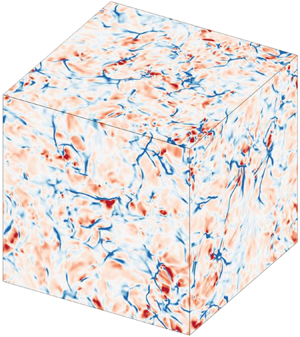Article contents
Interscale kinetic energy transfer in chemically reacting compressible isotropic turbulence
Published online by Cambridge University Press: 15 February 2021
Abstract

Interscale kinetic energy transfer in chemically reacting compressible isotropic turbulence is studied using numerical simulations at turbulent Mach numbers 0.2 and 0.8 for isothermal and exothermic reactions. At low turbulent Mach number  $M_{t}=0.2$ for exothermic reaction, heat release greatly enhances expansion and compression motions, and induces the formation of shocklets which are not observed for isothermal reaction at the same turbulent Mach number. It is found that heat release through exothermic reactions enhances both the positive and the negative components of pressure–dilatation, as well as positive and negative components of subgrid-scale (SGS) kinetic energy flux, indicating an increase of both forward-scatter and backscatter of kinetic energy. The SGS flux of kinetic energy has a tendency to be from large scales to small scales. The solenoidal components of pressure–dilatation and SGS kinetic energy flux are minorly influenced by heat release of reaction, while the dilatational components of pressure–dilatation and SGS kinetic energy flux are significantly intensified by heat release at all length scales. Heat release enhances the kinetic energy of the dilatational mode through the pressure work, and leads to the increase of dilatational kinetic energy transfer from large scales to small scales through dilatational SGS flux, as well as the viscous dissipation of dilatational kinetic energy at small scales. Taylor Reynolds number has a minor influence on the qualitative statistical properties of interscale kinetic energy transfer terms.
$M_{t}=0.2$ for exothermic reaction, heat release greatly enhances expansion and compression motions, and induces the formation of shocklets which are not observed for isothermal reaction at the same turbulent Mach number. It is found that heat release through exothermic reactions enhances both the positive and the negative components of pressure–dilatation, as well as positive and negative components of subgrid-scale (SGS) kinetic energy flux, indicating an increase of both forward-scatter and backscatter of kinetic energy. The SGS flux of kinetic energy has a tendency to be from large scales to small scales. The solenoidal components of pressure–dilatation and SGS kinetic energy flux are minorly influenced by heat release of reaction, while the dilatational components of pressure–dilatation and SGS kinetic energy flux are significantly intensified by heat release at all length scales. Heat release enhances the kinetic energy of the dilatational mode through the pressure work, and leads to the increase of dilatational kinetic energy transfer from large scales to small scales through dilatational SGS flux, as well as the viscous dissipation of dilatational kinetic energy at small scales. Taylor Reynolds number has a minor influence on the qualitative statistical properties of interscale kinetic energy transfer terms.
- Type
- JFM Papers
- Information
- Copyright
- © The Author(s), 2021. Published by Cambridge University Press
References
REFERENCES
- 12
- Cited by



